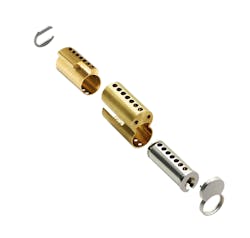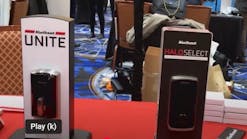Selling and servicing Interchangeable Cores provides dramatic growth and profit opportunities not previously available to the independent locksmith.
First: Seismic market and distribution changes are opening commercial, industrial and institutional accounts to the locksmith.
Major agents of change are:
- The Small Format Interchangeable Core (SFIC) that dominates large institutional and commercial markets has become the “open architecture” standard of domestic manufacturers.
- Better yet, quality SFIC brands are now available through your distributors.
- Brand-specific Large Format Interchangeable Cores (LFIC) offer numerous options for larger clients using those systems.
- Manufacturer consolidation reduces your commercial “core” inventory requirements.
Second: Electronic Access Control (EAC) and locks don’t compete; they need each other. When you can service EAC doors while helping maintain key control, you become a valuable single-source asset. Larger clients want problems solved.
Third: I/C cores still need to be pinned, codes maintained, and keys cut. Although very large organizations usually have well-staffed lock shops, medium sized companies often have a single person with part-time lock responsibility.
These issues create rapidly expanding opportunities in a locksmith business model that has been under attack in recent years. If you offer to do pinning and key cutting for the inside maintenance staff, you are well-positioned when he or she retires. Of course, make sure they understand you are there to make them successful, rather than threaten their jobs.
I/C cores exist because keys are lost, loaned, copied, and stolen. Employees are hired, transferred, and discharged, while departments are constantly added rearranged, or closed. As a result, key control typically deteriorates at a rate of 20 percent per year. Restricted keyways make copying very difficult, but the client still needs the ability to keep up with constant change. Documentation can have an enormous effect on maintaining key control, but precious few companies actually do it.
Organizations with a lot of doors, people, and something of value to defend are prime prospects not previously available to the locksmith. They need large master keyed systems, the ability to quickly revise keying, and well-run key control processes. Free or inexpensive training from suppliers can prepare you to serve these needs.
In the early 1920s, Seattle educator Frank Best became painfully aware that his large ring of keys was a nightmare to manage. Research revealed that the Yale® pin tumbler system offered major improvements over previous keying systems, if it could only fit into the plethora of lock types. Another problem he observed was that locks needed to be disassembled in order to re-key. Also, different plugs were used in different types of locks, cylinders, and padlocks. Yet another issue was the need for a single key that could open all locks in his area of responsibility.
Mr. Best developed the Interchangeable Core system that could be quickly re-keyed for mortise and rim cylinders, cabinets, padlocks, and others. Size constraints of various lock devices dictated what today we call the (SFIC) Small Format Interchangeable Core.
An unintended benefit was that the smaller pin segments allowed room for an additional barrel, quadrupling the number of available codes – which became an important issue for large facilities. As usual, major lock manufacturers of the time weren’t interested in change. Mr. Best was forced to make his own I/C core system and go direct to the customer.
SFIC or LFIC ?
As the Best® type SFIC became popular with larger organizations, other manufacturers developed their own I/C cores that were pinned the same as their existing standard plugs or cylinders. LFIC cores are however, “brand specific,” and have only six barrels.
Corbin Russwin has large side locking lug; SARGENT® has smaller side lug; Yale has rear lug; and Schlage® uses rear pin.
These LFIC cores do however, provide additional space where sidebars and increased tamper resistance can be built-in. UL437 standards (picking, impressioning, and destructive entry) can be incorporated in LFIC cores when useful. Medeco® offers a wide range of these security options for LFIC as well as SFIC cores, including electronic.
The Best type SFIC format is considered the “open architecture” design supplied by all domestic manufacturers. Drill and tamper resistant pin segments can be installed. Reinforced locking lugs, plus restricted and tamper resistant keyways are now also available.
SFIC mortise and rim cylinders are available rated for UL437. Montreal based CX5, Medeco and Schlage build both large and small format I/C cores, while Arrow, Best, Oak, Marshall Best and aftermarket manufacturers specialize in SFIC cores. Pay attention to core and pin quality.
Electronics
Electronic Access Control has NOT replaced the I/C core, although it is migrating into the core. Currently, Medeco and CyberLock® produce electronic keys that read, write, and provide power to unlock a mini-solenoid or motor in electronic I/C Cores.
The Assa® CLIQ™ key works in electronic or manual cores as a normal key would. All electronic cores contain a read/write microchip with authorized users, location data, and audit trail. These products are available in SFIC, LFIC and other configurations which can be integrated into existing systems.
As RFID chip technology progresses, along with Near Field Communication (NFC) and Bluetooth® Low Energy (BLE), we will see some very interesting developments in smart keys and I/C cores.
Cost-effective security happens when you help your client balance Electronic Access Control with lock system management. Traditional EAC at portals and choke points allow your client to know who came in, and when. Audit trails, time and zone controls, plus access privilege termination, are valuable for primary entrances, but overwhelmingly costly for use on every door – at the present.
Day to day access to interior offices or closets is far more cost-effective with I/C equipped locks. When your shop can service EAC doors as well as I/C cores, you become a valuable partner.
Business Growth Opportunities
Two distinct types of larger operations exist. The first is the very large organization with a well-staffed professional lock shop. Make friends with the manager and offer to handle overload pinning and key cutting off-site to back them up when needed. Be his friend, but use quality parts !
Your business growth opportunity is in the medium sized facility with a part-time lock staff. This type of operation will often have a very small lock shop – possibly even a janitor’s closet. When you offer to pin cores and cut keys off-site for them, you become part of the team. Part-time shop help can pin batches of I/C cores for you far less expensively than field technicians. When you give the customer helpful insider maintenance tips, you make him or her look good while building trust.
The bottom line is to ask questions, listen, reflect the customer’s concerns back to him or her, and focus on your customer’s need. Customers quickly sense whose interest you really are serving.
Best and Schlage both have excellent training documents for SFIC protocols. Search for “Best core and key service manual,” and for “Schlage SFIC service manual.” A one-day hands-on class is strongly recommended.
The SFIC “A2” system with .0125” increments provides 16,384 codes in 7-pin versions – which is a really big deal for large clients. The “A2” system uses only even or odd pin numbers in a given barrel, yielding a total of .025” space between cuts.
The SFIC “A4” system has increments of .021” and 78,125 codes with 7-barrels, but does not offer the even-odd flexibility of the A2 system. It is not as widely used.
Semi-skilled pinning should produce 10-cores per hour in shop conditions; pinned, capped, two keys cut and tested. We’ve seen nimble fingers produce 14 to 17-cores per hour. Although colored pin segments are much easier to distinguish, many experienced locksmiths suggest that certain others operate more smoothly.
Lubrication
SFIC and larger cores with precision features have far closer tolerances and are therefore more susceptible to dirt and lube issues. A few years back Best did some testing and found powdered graphite good for about 100,000 cycles, LPS-1 for 50,000, and Poxylube® for 25,000 cycles. The Poxylube 200 was very effective for cleaning the core.
The LPS 1® and Poxylube dried after a few hours and did not collect dust. Medeco currently recommends the lanolin based Fluid Film® which requires periodic re-application. They also recommend a high quality contact cleaner for flushing out dirt and debris.
It appears that a light application of powdered graphite in a clean core always gives outstanding results, but liquid versions seemed sluggish. A number of interesting YouTube “lock lubrication” videos offer varying opinions, but powdered graphite always comes up a winner. Whatever you use, check it a year later. If the lube doesn’t dry completely, it will collect dirt!
This modified control (CT) key was created to ride over toothpicks and debris to operate the locking lug shear line. For the first step, the key is inserted into a good I/C core and the insertion depth marked near the bow. The CT key is then filed down from tip to bow, allowing it to ride up over the debris. The modified CT key essentially becomes a dedicated CT shear-line pick.
Be sure that critical operational key features are not removed.
Although we could offer many hours of additional tips and details, you get the picture. The bottom line is that major market and distribution changes are squeezing you one way, but also opening huge opportunities for you to service some very large I/C core systems.
Cameron Sharpe
Cameron Sharpe, CPP, worked 30 years in the commercial lock and electronic access industry. Contact him at [email protected].






